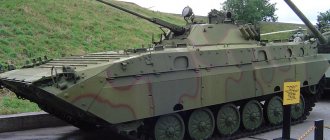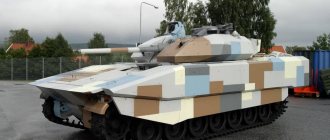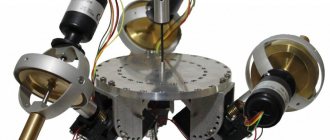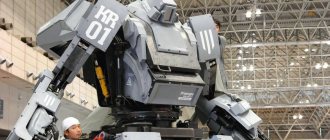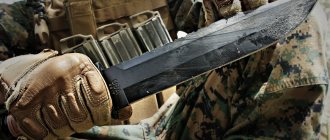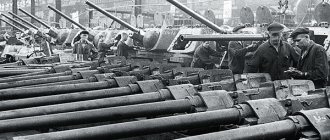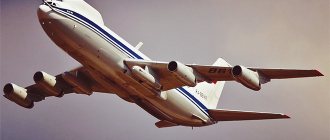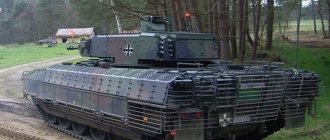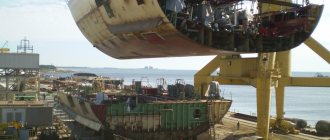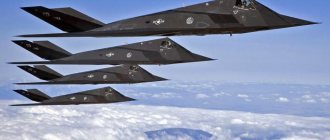The Russian Armed Forces are working on a program for the development of Russian armored vehicles. It is based on conclusions obtained after the Zapad-2021 exercise, as well as on the results of other experimental maneuvers where new infantry fighting vehicles (IFVs) were tested, the Ministry of Defense told Izvestia. In 2022, they tested the T-15 based on the Armata and the B-19 with the Epoch remote module equipped with a 57 mm cannon. The vehicles were tested in training defensive and offensive battles, as well as on the march. Izvestia was looking into whether they would be able to radically strengthen the combat power of Russian troops and influence the course of hostilities as a whole.
Freccia
The Italian Freccia infantry fighting vehicle is considered one of the best combat vehicles in the world. The 8-wheeled model was created by FIAT in 1996.
Main features of the BMP:
- 26 t (weight);
- 3/8 (crew/troops);
- VTCA diesel engine (110 km/h);
- 800,000 m (power reserve);
- 25 mm Oerlikon KBA (automatic gun);
- 7.62 mm (machine guns);
- Spike ATGM;
- protection against 30 mm armor-piercing projectile, 7.62 mm bullet.
Advantages:
- fast acceleration to maximum speed;
- excellent armor.
Flaws:
- low rates of hitting the target (on the move);
- poor off-road performance.
Under the umbrella
“In the Ground Forces there are organizational structures of three types of formations,” military expert Viktor Murakhovsky told Izvestia. “In particular, it is planned to create heavy formations that will be equipped with T-15 tanks and T-14 infantry fighting vehicles, created on the Armata platform.” Also in the armed forces there are formations based on medium tracked platforms, primarily on vehicles of the BMP-3 family. The new B-19 infantry fighting vehicle with the Epoch module also belongs to this type. There are also known standard structures of light formations that move wheeled infantry fighting vehicles and other vehicles built on this platform.
T-15 infantry fighting vehicles based on the Armata have powerful tank armor, which allows them to reliably protect the crew and motorized riflemen located in the troop compartment. For this reason, the T-15 BMP will most likely go into service with strike units, which are supposed to break through well-prepared enemy defenses equipped with engineering structures, the expert believes.
Armor field
BMP T-15
Photo: IZVESTIA/Zurab Javakhadze
“Epoch” is coming: “super-infantry fighting vehicle” will receive an upgrade and a road map
How new technology and electronics will help save the lives of soldiers
“The powerful armor of the T-15 will allow us to implement such a tactical technique as a single armored battle formation - with it, tanks and infantry fighting vehicles are in the same formation, without a gap in depth,” explained Viktor Murakhovsky. “Now motorized infantry, due to the weakness of the armor of infantry fighting vehicles, dismount long before the enemy’s first line of defense. Heavy infantry fighting vehicles are capable of withstanding enemy fire from ATGMs, tank-caliber guns and other weapon systems from frontal and heading angles, which provides new opportunities for motorized infantry. For example, it allows the command to designate a dismount line for motorized rifles directly at the enemy’s front line or even behind it. An umbrella of exploding shells will help break through the defense, which will reduce the enemy’s use of anti-tank weapons to almost nothing. Such an attack should lead to a breakthrough of any prepared defense. But the new tactics have yet to be worked out in detail at training grounds in order to understand all the nuances.
In the USSR it was tested in several exercises. But at the training grounds it quickly became clear that the thin armor of Soviet infantry fighting vehicles did not allow such attacks to be carried out - the attackers suffered too many losses. At this point the experiment was completed, but the idea was not forgotten and its implementation became possible after the advent of heavy infantry fighting vehicles, the expert concluded.
Heavy shock regiments, brigades or divisions will appear in the Ground Forces in earnest and for a long time. They will interact with formations armed with medium infantry fighting vehicles, experts say.
Armor field
BMP-3 at the strategic command and staff exercises Caucasus-2020
Photo: IZVESTIA/Zurab Javakhadze
“Terminator” has become operational: two BMPT companies will appear in the 90th Tank Division
How armored “tank killers” will establish interaction with motorized rifle and tank units
“Medium infantry fighting vehicles, including the B-19, can float,” military expert Alexei Khlopotov reminded Izvestia. — Rivers or other water barriers have never been a hindrance for them, and this feature influences a lot. Here, with amendments, of course, techniques that were tested in the second half of the Great Patriotic War can work. With this tactic, formations with heavy tanks and infantry fighting vehicles will push through the defense, after which units with B-19 or BMP-3 will begin to break through - they will have to build on their success behind enemy lines. Medium infantry fighting vehicles will also be indispensable when capturing bridgeheads; unlike the T-15, they do not need bridges or searching for a suitable section of the river to cross along the bottom.
The choice of units with a certain type of infantry fighting vehicle may depend on the specifics of the theater of operations and the enemy’s weapons. In Europe, for example, there are many rivers and in case of a deep breakthrough it is better to use medium infantry fighting vehicles. The wars in the Middle East and Afghanistan have shown that a heavy combat vehicle that provides reliable protection for the crew will certainly be in demand there.
Warrior
British tracked infantry fighting vehicle, developed in the 70-80s by GKN Sankey. The latest modification is Warrior 2000.
Description of the BMP:
- 23.5 t;
- 3/7 people;
- CV8 TCA diesel engine (75 km/h);
- 500,000 m without refueling;
- 30 mm L21A1 Rarden gun or 40 mm CTAI;
- 7.62 mm L94A1 (machine gun);
- 2 x 4 smoke grenade launchers;
- from 25 mm BPS, from 14.5 mm B-32 (security).
Pros:
- all-terrain model;
- high shooting accuracy at medium speed.
Minuses:
- lack of stabilization in Rarden;
- high price.
Design
The BMP-2 is an infantry fighting vehicle that has an identical layout to the BMP-1. The main difference between them is the presence of different weapons. The crew consists of three people. The vehicle can also accommodate up to seven landing personnel, who can fire through the loopholes.
The body and turret of the vehicle are welded from rolled steel sheets, the thickness of which is from 5 to 19 millimeters. The thickness of the frontal armor of the turret is up to 23 mm. The tower has the shape of a truncated cone.
The BMP-2 is equipped with a 6-cylinder diesel engine UTD-20S1 with liquid cooling, the engine weight is 700 kg.
Engine power 300 hp A dry-type double-disc clutch with mechanical control is used. The gearbox is five-speed with synchronizers in the four highest gears. Planetary gearboxes are used to turn the machine.
The chassis has six track rollers, which are a movable support for the body on the caterpillar track. The maximum speed that the car can reach is 65 km/h on the highway and up to 45 km/h when driving over rough terrain. The equipment is capable of independently crossing bodies of water, reaching speeds afloat of up to 7 km/h. Movement through water is accomplished by rotating caterpillars. Because of this, difficulties arise when moving the machine against the current.
The BMP-2 is controlled using a steering wheel with a steering wheel design. Thanks to the free rotation of the steering wheel, control does not require significant effort. When the steering wheel is turned, there is a smooth change in traction on the tracks, which ensures smooth turning and protects the chassis elements from overloads. When the steering wheel is released, control automatically returns to straight-line motion.
The BMP-2 uses the following communications and surveillance equipment:
- internal intercom model A-3;
- radios R-123M, R-173 or R-126;
- surveillance devices TNP-165A or TNPO-170A;
- device for monitoring at night.
The weapons include:
- 30 mm gun 2A42;
- PKT machine gun (Kalashnikov tank machine gun);
- missile system "Fagot" or "Konkurs".
MOWAG Piranha V
Swiss combat vehicle of the 5th generation. The 8-wheeled model was first introduced in 2010.
Features of the BMP:
- 33 t;
- 3+8 passengers;
- diesel engine MTU 6V199 TE21 or Scania DC13 (100 km/h);
- 1000 km without refueling;
- 12.7 mm machine gun;
- 30 mm autocannon;
- 40 mm grenade launcher (TOW anti-tank missile);
- from 30 mm and 14.5 mm shells (armor-piercing protection).
Advantages:
- large power reserve;
- possibility of installing any weapon.
Flaws:
- low traffic;
- heavy weight.
Performance characteristics
The table shows the performance characteristics of the Soviet infantry fighting vehicle in comparison with foreign analogues, such as the American M2 Bradley infantry fighting vehicle and the Swedish Strf 90.
| Options | BMP-2 | M2 "Bradley" | Strf 90 |
| A country | USSR/Russia | USA | Sweden |
| Crew/troopers, persons | 3/7 | 3/6 | 3/8 |
| Length/width, mm | 6735/3150 | 6452 /3200 | 6550/3170 |
| Main weapons | 30 mm auto. gun 2A42 | 25 mm auto. Bushmaster cannon | 40 mm auto. Bofors L-70 gun |
| Missile weapons | ATGM "Fagot" / "Competition" | ATGM TOW/BGM-71 | — |
| Reservation, mm | 6-23 | 14-25 | up to 30 |
| Weight, t | 14 | from 22 | 23-35 |
| Highway speed | 65 | 66 | 70 |
| Cruising range, km | 600 km | 480 km | 320 km |
| Obstacles to be overcome ditch/wall, m | 2,5/07 | 2,5/0,9 | 2,5/0,5 |
In the 70s, the United States developed the Bradley infantry fighting vehicle, which began rolling off the assembly line in 1981. If we compare the combat qualities of the BMP-2 and M2 Bradley, they are equivalent. In the event of a combat confrontation between these vehicles, the experience of the crew is of great importance.
The American model is undergoing more than one modernization, which is why the BMP-2 began to lag behind in many respects. Next, Russia also improved the combat vehicle, which again became competitive with the American one.
BMP-3
Russian armored tracked vehicle. The BMP has been produced since 1987.
Main characteristics:
- 18.7 t (weight);
- 3/7 people (crew/troops);
- UTD-29M diesel engine (70 km/h);
- 600,000 m without refueling;
- 2A70 (100 mm gun);
- 2A72 (30 mm automatic gun);
- ATGM 9M 117;
- 7.62 mm machine gun;
- from 30 mm BT and 12.7 mm B-32 (protection);
- $1.17 million (price).
Pros:
- in the latest models, an improved combat module (“Berezhok”, “Epoch”);
- good shooting accuracy.
Minuses:
- small power reserve;
- sensitivity to diesel fuel composition.
Current trends in the development of infantry fighting vehicles: weapons control systems
The layout of the turrets of infantry fighting vehicles (IFVs) and their cannon armament, which were discussed in previous articles in the series, are only part of the parameters that affect the combat capabilities of armored vehicles. The third important element influencing the effectiveness of its combat use is the weapons control system (WCS).
Weapon control systems on infantry fighting vehicles appeared relatively recently. —
in the 90s of the last century. Until that time, a typical infantry fighting vehicle had only a few simple sights, which at best allowed you to manually enter some parameters (air temperature, wind speed, etc.). Increasing requirements for the effectiveness of the weapons of infantry fighting vehicles, which have become the main combat weapon of mechanized platoons, required the introduction of SUVs, approaching the complexity of tank ones. When comparing the combat capabilities of modern infantry fighting vehicles, it is necessary to take into account the capabilities of their SUVs.
A clear example is the comparison of the BMP-3 and M2A3 Bradley. At first glance, the BMP-3, armed with a 100-mm low-pulse gun and a coaxial 30-mm automatic cannon, has an absolute advantage over its American counterpart, armed with only a 25-mm cannon and a coaxial Tou ATGM launcher. However, the IBAS SUV installed on the M2A3 gives the American infantry fighting vehicle the ability to fire on the move, similar to the M1A2 tank. Together with the modified suspension, which improves the accuracy of fire, this evens out the competition's chances. In addition, the M2A3 is well protected from armor-piercing shells of 30 mm cannons (the only danger for it is the new sub-caliber finned shells). At the same time, the armor of the BMP-3 is penetrated by shells from the 25-mm Bushmaster cannon at combat distances typical for the European theater of operations (about 1 km).
We will not be able to analyze the weapon control systems of all modern infantry fighting vehicles in this material, so we will focus on some of the most illustrative examples.
BMP-2
This infantry fighting vehicle is far from new, but continues to be used and fought in many countries. At the time of adoption (1981), the BMP-2 was probably the best in its class. The 30-mm 2A42 cannon mounted on it has a solid ammunition load, ready to fire (500 shells, including 160 armor-piercing tracer and 340 high-explosive fragmentation incendiary shells). The electro-hydraulic stabilizer provides an average gun stabilization error of 1 mrad at a distance of 1 km (at an infantry fighting vehicle speed of up to 25-35 km/h). Although this figure was approximately 2.5 times worse than that of tanks of the 80s, it became unique for infantry fighting vehicles of those times.
BMP-2 infantry fighting vehicle. mil.in.ua
Contrasting with the successful armament of the BMP-2 is the lack of an SUV as such. The vehicle commander has a combined (day and night) observation device TKN-3B with an infrared searchlight OU-ZGA2, two periscopic observation devices TNPO-170A and one TNPT-1, as well as an anti-aircraft sight 1PZ-3. The gunner uses the BPK-1-42 sight, as well as three TNPO-170A and one TNPT-1 devices.
From a modern point of view, the TKN-3B device is very primitive. Its night channel provides a range of no more than 400 m in passive mode, while turning on the infrared spotlight immediately unmasks the vehicle. And a constant 5x magnification with a field of view of 10° (in night mode - 3x and 8°, respectively) was not something outstanding even in the 80s.
But for all its primitiveness, the TKN-3B has two important advantages. Firstly, it is mounted in the commander’s hatch, which is movable in the azimuthal plane, making it a panoramic device. Secondly, it provides the function of bringing the turret (and therefore the gunner’s sight) to the TKN-3B axis. That is, the BMP-2 sighting and surveillance equipment implements the “hunter-killer” principle, but with one significant drawback. On the T-64B and T-80B tanks there is an electric motor that rotates the commander's cupola in the direction opposite to the rotation of the tower, and thereby automatically keeps the commander's instrument mark on the target. The BMP-2 does not have such an engine, and keeping the target in the field of view is done manually. Thus, implementing the “hunter-killer” principle in motion is an extremely difficult matter.
TKN-3 device. ua.all.biz
The combined (day/night) gunner's sight BPK-1-42 was archaic: it corresponded to the level of development of optoelectronics of the 60s. Its only positive quality was stabilization in two axes. In 1986, it was replaced by the improved BPK-2-42 sight. Another disadvantage of the BMP-2 sighting and surveillance equipment is the insufficient field of view of the commander’s and gunner’s periscope observation devices. In total it is only 120°, which makes the crew practically blind. At the same time, the commanders of the Marder and M2 infantry fighting vehicles have a set of periscopes installed around the circumference of the hatch and providing all-round visibility. On the other hand, the infantry fighting vehicles of NATO countries in the 80s did not even have primitive “hunter-killer” systems similar to those used on the BMP-2.
While the Marders and Bradleys were continuously improved, having gone through several stages of modernization by the beginning of the 21st century, the BMP-2 remained in its basic design - in the USSR, and then in Russia, the main emphasis was placed on the new BMP-3. Only when it became clear that the BMP-3 would not be able to completely replace its predecessor, and the promising Kurganets-25 infantry fighting vehicle would not soon reach the troops, the BMP-2 modernization program was initiated. Its main element is the installation of the Berezhok combat module. In essence, it is a deeply modernized BMP-2 turret. The main armament - a 30 mm cannon with a coaxial 7.62 mm machine gun - remained unchanged. A 30-mm AGS-17 automatic grenade launcher is installed outside the rear of the turret (this decision is not controversial and has been criticized both in Russia and abroad). Two double-charged Kornet ATGM units are installed on the sides of the turret.
BMP-2M with the Berezhok module. topwar.ru
The Berezhok module is equipped with a new electromechanical stabilizer, which provides greater stabilization accuracy and a higher horizontal aiming speed. The Berezhka SUV is very advanced: in its capabilities it even surpasses the SUV of modernized tanks, including the T-72B3M. Data from the weather sensor and other sources are entered into the ballistic computer automatically. The commander received a stabilized panoramic sight with a thermal imager, a laser range finder and an automatic target tracking device (auto tracker). The image from the sight is displayed on the monitor. The gunner's sight with a variable field of view (from 4° to 20°) is also stabilized and equipped with a thermal imager and a laser rangefinder. Both sights are equipped with thermal imaging cameras, which are Russian copies of French devices of the Catherine series. As a result, the BMP-2M with the Berezhok module corresponds in its firing capabilities to the M2A3 BMP with the IBAS SUV. At the same time, the modernization did not affect the armor protection of the BMP-2, which by modern standards is extremely weak.
Algeria became the first buyer of Berezhok modules: in 2005, it ordered 340 such products. Currently, a program is being implemented to modernize 327 Russian BMP-2s to the BMP-2M level.
CV90
The Swedish CV9040 infantry fighting vehicle (military designation Strf 9040) is a good example of the gradual improvement of an SUV, which led to a significant improvement in its capabilities. Initially, the Swedish ground forces expected to receive a relatively simple combat vehicle, devoid of complex technical solutions and, accordingly, inexpensive. As a result, the Strf 9040 received a 40-mm Bofors cannon with excellent ballistics, but a bulky and unproductive loading system. In addition, the gun did not have a stabilizer. The composition and capabilities of the SUV of this infantry fighting vehicle were very modest. The commander used six periscopes installed around the circumference of the commander's turret for observation. Three similar gunner observation devices provided a field of view 180° to the right of the longitudinal axis of the turret. The MYBOF ballistic computer automatically receives data on wind strength, ambient temperature and ammunition, and BMP movement parameters. The UTAAS combined sight has a night channel on an electron-optical converter and a built-in laser rangefinder.
By the time the Strf 9040 BMP was put into service (1991), the capabilities of its SUV, to put it mildly, were not impressive. The lack of gun stabilization, the lack of a thermal imager, the impossibility of implementing the “hunter-killer” principle - all this greatly limited the combat capabilities of the vehicle. On the other hand, the MYBOF ballistic computer and the UTAAS sight included opportunities for modernization. Their implementation began in 1997, when the Strf 9040A BMP was equipped with a two-plane weapon stabilizer, a thermal imaging camera (integrated with a UTAAS sight) and an improved ballistic computer. The Strf 9040B variant, which appeared in the new millennium, received a new weapon stabilizer and more powerful horizontal guidance drives (the need to install them was determined by the increased mass of the turret). In addition, the vehicle was prepared for the installation of the LEMUR command panoramic device, but the installation of the latter had to be abandoned due to financial restrictions. The new stage of modernization, which led to the appearance of the Strf 9040С variant, did not affect the elements of the SUV.
BMP Strf 9040V. fighting-vehicles.com
Export versions of the CV 90 are distinguished by a slightly different SUV composition, determined by the requirements of a specific customer. Norwegian infantry fighting vehicles CV9030N (1994) received a stabilized 30-mm Bushmaster cannon. The UTAAS sight has a built-in thermal imaging camera (albeit with rather modest parameters). The commander received his own sighting and observation device (non-panoramic) “SFIM/Sopelem” with variable magnification (1x and 16x). There is no night channel in this sight, but there is an eyepiece from the thermal imager of the UTAAS sight. The Swiss CV9030CH infantry fighting vehicles (ordered in 1999) also received a similar SUV composition. The most “advanced” SUV was received by the Dutch CV9035NL infantry fighting vehicles (ordered in 2004). The Katrin XP thermal imager is integrated into the UTAAS sight. The commander received a sighting and observation device (non-panoramic) “Tales” MT-DNGS with its own thermal imager and (optional) laser rangefinder. The MT-DNGS field of view is 30° (at 6x magnification it decreases to 6°). In addition, the CV9035NL SUV BMP provides the ability to use projectiles with programmable fuses.
BMP СV9030CH. fighting-vehicles.com
Using the example of the CV90 family infantry fighting vehicle, we clearly see the advantages of the open SUV architecture, two key elements of which (UTAAS sight and MYBOF ballistic computer) have significant opportunities for modernization. Thanks to this, in their newest versions (CV9035NL and, to a lesser extent, Strf 9040В/С), these infantry fighting vehicles meet modern requirements, surpassing not only the BMP-2, but also some newer combat vehicles (for example, the Austrian Ulan).
"Puma"
The German Puma IFV is an example of an uncompromising approach to providing as much firepower as possible. Its design combines avant-garde technical solutions with German pragmatism. The hydropneumatic suspension turns the BMP into a very stable platform for firing. When choosing the main armament, German specialists did not succumb to the “fashion” for systems with an external drive, giving preference to the 30-mm MK 30-2 cannon, the automation of which works on the principle of removing part of the powder gases. Such a gun weighs 40% more than a Bushmaster of the same caliber, but has a lower recoil impulse, which has a positive effect on shooting accuracy. The external frame gives the gun barrel additional rigidity: this neutralizes the effect of barrel heating on the accuracy of fire. The gun is equipped with a two-plane stabilizer. It is possible to use projectiles with programmable fuses.
BMP "Puma". hiveminer.com
The weapons control system of the Puma infantry fighting vehicle is superior in some respects to the SUV of modern tanks, including the Leopard-2A7. It makes it possible to implement the “hunter-killer plus” principle, which provides for complete interchangeability of the functions of commander and gunner and corresponding duplication of sighting and surveillance equipment. The gunner has a stabilized EOTS sight, which includes a color television camera, an Attica thermal imager and a laser rangefinder. "Attika", which belongs to the 3rd generation of thermal imagers, is equipped with an additional optical scanning device that increases the separation capacity to 768x576 pixels - an exceptionally high indicator for SUV thermal imagers of combat vehicles. The image from the sight is transmitted to the monitor of the gunner or commander (or both of them simultaneously).
The PERI RTWL-B commander's sight consists of a television camera, an Attica thermal imager and a laser rangefinder. The image from the sight can be transmitted digitally to the monitors of the commander and gunner, but, in addition, the designers retained the traditional optical channel. The fact is that, despite progress in electronics, it is still not capable of achieving the same quality of image transmission as a direct optical channel. In the PERI RTWL-B sight, such a channel is capable of transmitting an image of 6 megapixels.
Sight PERI RTWL-B. hensoldt.net
The Puma SUV includes a fully digital ballistic computer, but does not have an auto-tracking mode. According to German experts, this mode, which consists of accompanying a target mark from a thermal imager or its contours in a daytime channel, is unreliable in European conditions due to the presence of artificial and natural obstacles on the battlefield (buildings and structures, terrain folds, etc.). However, in the future, “Puma” may have the ability to auto-track – but not ground targets, but air targets (micro- and mini-UAVs).
The high characteristics of the SUV BMP "Puma" were confirmed during competitive tests in the Czech Republic in 2022. Five infantry fighting vehicles took part in them: ASCOD 2, two variants of CV9030, Lynx and Puma. All of them were armed with 30-mm cannons and equipped with SUVs with theoretically similar capabilities. During practical shooting from a place and on the move from distances of 1200 and 1800 m, which took place in strong wind conditions, the Puma completely defeated its competitors: 37 out of 40 shells hit the targets (firing was carried out in five-round bursts). The closest competitor was able to “place” half as many shells on the target.
A very “advanced” and effective “tank” SUV, used on the Puma infantry fighting vehicle, led to a significant increase in its price, the share of SUV in which reaches 40%. The downside is increased security requirements. An infantry fighting vehicle with a tank SUV costs like a tank, so the level of protection must be high - at least minimizing the likelihood of its own infantry fighting vehicle being hit by fire from similar enemy vehicles. If in the 50-80s, armored personnel carriers and infantry fighting vehicles were relatively cheap vehicles, which contributed to their popularity, then modern infantry fighting vehicles of the Puma level (or slightly lower) are unlikely to become truly widespread. Probably, even in the armies of developed countries they will have to be supplemented with cheaper solutions. In a certain sense, this option has already been tested in the US Army, where, along with the Bradley infantry fighting vehicle, the Stryker armored personnel carrier is widely used.
Literature:
- Dąbrowski M. Nowy bojowy wóz piechoty – oczekiwania i możliwości // Nowa Technika Wojskowa. – 2016. – No. 9
- Wolski J. Kierunki rozwoju siły ognia BWP // Nowa Technika Wojskowa. – 2022. – No. 12
- Wolski J. Systemy kierowania ogniem i uzbrojenie przeciwpancerne // Nowa Technika Wojskowa. – 2022. – No. 1
Sonderkraftfahrzeug 251
The German half-track transporter was produced from 1939 to 1945.
The latest modification is Sd.Kfz. 251/23.
Main characteristics:
- 9.14 t;
- 2+10 passengers;
- Maybach carburetor engine (53 km/h);
- 7.92 mm MG-34 or MG-42 (machine gun);
- 20 mm tank gun;
- from 14.5 mm shells (protection).
Advantages:
- good maneuverability;
- capacity 12 people.
Flaws:
- weak armor protection;
- small power reserve (300,000 m).
ZBD-08
Chinese 8-wheeled infantry fighting vehicle. Produced since 2006.
Description of the BMP:
- 21.5 t;
- 3+7 people;
- diesel engine BF6M1015C (100 km/h);
- 800,000 m without additional refueling;
- 30 mm ZPT-99 gun;
- 7.62 mm PKT machine gun;
- ATGM HJ-73;
- 30 mm and 14.5 mm (protection).
Pros:
- in new versions 100 mm cannon;
- armor improved.
Minuses:
- average cross-country ability;
- swimming capabilities are reduced.
Device
BMP-2 is, in fact, a deeply modernized BMP-1. Both of these combat vehicles are 80% identical. The BMP-2 has the same layout as its predecessor. The engine and power compartment are located at the front, the control compartment is also located there, and the fighting compartment is in the very center of the vehicle. At the rear there is a troop compartment that can accommodate six paratroopers. The entire rear part of the vehicle is occupied by doors designed for landing infantrymen.
The vehicle's armor is rolled and welded. The armor protects the crew and paratroopers from shrapnel, small arms fire and weapons of mass destruction. The troop compartment has special embrasures equipped with ball mounts that allow firing from personal weapons. The landing compartment is divided into two parts by a fuel tank.
The main difference between the BMP-2 and the BMP-1 is the weapon system. The new vehicle is equipped with an automatic 30-mm 2A42 cannon with 500 rounds of ammunition. Thanks to this gun, which has a large elevation angle, the BMP-2 can fire at low-flying air targets. The rate of fire of 2A42 is up to 550 rounds per minute. A machine gun was also installed on the BMP-2, and the Fagot or Kornet ATGMs can be used on the vehicle to destroy armored vehicles.
To install new weapons on the BMP-2, a new, more spacious turret was equipped. The gun is stabilized in two planes; this device allows it to fire on the move. The turret has seats for the gunner and vehicle commander. Thanks to new, more advanced sighting devices and observation devices, both the vehicle commander and the gunner can now fire.
Compared to the previous vehicle, the number of paratroopers and their placement have changed. The landing compartment can accommodate six soldiers, and there is another place for an infantryman behind the driver.
The BMP-2 has a more advanced engine with a turbocharging system. The design of the chassis and transmission remained the same. A more advanced smoke screen installation system has been added, which consists of thermal smoke equipment and six “Tucha” smoke grenade launchers. The machine is equipped with a fire extinguishing system.
The installation of a new larger turret increased the weight of the vehicle, however, the BMP-2, like the BMP-1, can float. The speed of movement on water is 7 km/h, the movement occurs due to the rewinding of the tracks.
Video about BMP-2
M1126 Stryker
American 8-wheeled armored vehicle. Produced since 2002.
Features of the BMP:
- 17.2 t;
- 2+9 passengers;
- Caterpillar diesel engine (97 km/h);
- 531 km without refueling;
- 40mm Mark 19 grenade launcher;
- machine guns 12.7 mm M2 Browning or 7.62 mm M240;
- steel and composite (Mexas) protection.
Advantages:
- convenient door (ladder) for landing;
- enhanced armor protection.
Flaws:
- poor cross-country ability;
- low buoyancy.
The Universal Carrier
British tracked armored personnel carrier from World War II. Praying Mantis is the latest experimental modification.
Description:
- 3,800 kg;
- 1+4 people;
- carburetor 8-cylinder engine (48 km/h);
- 225,000 m without refueling;
- 37 mm anti-tank gun;
- 7.7 mm Bren or 13.9 mm PTR Boys machine guns;
- rolled steel armor.
Pros:
- relatively high maneuverability;
- used as a tractor.
Minuses:
- weak firepower;
- problems with the chassis.
M1114
American armored 4-wheeled vehicle 2nd generation HMMWV. Used for the needs of the US Armed Forces.
Description of the BMP:
- 5,489 kg;
- 5 people;
- diesel engine (125 km/h);
- 12.7 mm M2 machine gun;
- 40 mm Mkl 9 grenade launcher;
- armor against 7.62 mm bullets, mine fragments and shells.
Advantages:
- armored windshield;
- good visibility.
Flaws:
- low level of armor protection;
- average cross-country ability.
Combat use
BMP-2 took the most active part in the Afghan war. In Afghanistan, combat vehicles suffered heavy losses (one thousand three hundred units, including BMP-1, BMP-2, armored personnel carriers, BRDM). They took part in the war between Armenian and Azerbaijani armed forces in the struggle for Nagorno-Karabakh (1988-1994).
Later the machines took part in conflicts:
- in the first (1994-1996) and second Chechen war (1999-2009);
- during the civil war on the territory of Tajikistan (1992-1997);
- on the territory of South Ossetia (2008);
- in battles in the south-east of Ukraine (since 2014);
- took part in military operations in Angola.
They were also used in the Iraq War, where, according to some reports, three Abrams tanks were disabled by shots from the BMP-2 automatic cannon. Used by Syrian troops in the fight against militants.
Today, the BMP-2 is in service with many countries around the world.
Unlike foreign analogues, it has a wide range of applications in various combat situations and is easy to operate. The unique structure of the machine makes it possible to quickly modernize it. BMPs are of some interest on the international arms market. Despite the weakness in armor and some other shortcomings, this vehicle has great prospects for further development.
"Kurganets-25"
Russian tracked platform for infantry fighting vehicles from Rostec. Produced since 2015. Used to improve outdated machines.
Main characteristics of infantry fighting vehicles based on the Kurganets-25 platform:
- 25,000 kg;
- 3+8 passengers;
- 80 km/h;
- 30 mm autocannon 2A42;
- 7.62 mm machine gun;
- ATGM "Kornet";
- protection from art. shells.
Pros:
- computerized combat module;
- high shooting accuracy.
Minuses:
- no automatic grenade launcher;
- profile vulnerable to a grenade launcher.
Probation
As sources in the military department told Izvestia, work on a program for the development of Russian armored systems is already underway. The new document pays special attention to the integration on the battlefield of unique weapons systems - B-19 and T-15 infantry fighting vehicles. A concept for their use, an organizational structure of units equipped with this equipment, as well as a personnel training program are being developed. The results of the use of armored vehicles during maneuvers in 2022 are being studied, where they were deployed in conditions as close as possible to combat ones. The initial information for analysis has already been collected . Previously, the Ministry of Defense reported that at the Zapad-2021 strategic exercises at the Mulino training ground in the Nizhny Novgorod region, fire support for units on the main defensive line was provided by the latest B-19 infantry fighting vehicles with the Epoch combat module. The actions of the machine were observed by Russian President Vladimir Putin.
Photo: Ministry of Defense of the Russian Federation
BMP B-19
On the eve of the New Year, the Commander-in-Chief of the Ground Forces, Army General Oleg Salyukov, said that the B-19 BMP is currently undergoing various types of tests, after which it is planned to be put into service.
Exercises "Armate": crews will begin to be trained for heavy infantry fighting vehicles
Where will the first special classes for cadets be opened?
Izvestia has already written that starting next year, commanders will begin to be trained for heavy infantry fighting vehicles T-15 of the Armata family. Their training will be conducted at the Far Eastern Higher Combined Arms Command School in Blagoveshchensk. It is known that the Russian Ministry of Defense has a contract for the supply of a battalion set of T-15 infantry fighting vehicles. Now this armored vehicle is being tested.
Marder
German tracked armored vehicle of the 70s of the last century. The latest version is Marder 2 M12.
Description of the BMP:
- 42.6 t;
- 3+7 passengers;
- motor MTU MT 881;
- 75 km/h;
- 30-mm gun MK-30-2;
- 7.62 mm machine gun;
- ATGM "Milan";
- from 30 mm BPS, 20 mm Rh202, cumulative BE (protection).
Pros:
- digital firing system;
- enhanced armor protection.
Minuses:
- heavy weight;
- high price.
The concept of the BMP-1 and the history of its creation
In the mid-60s of the last century, it became clear that the BTR-50P armored personnel carrier was outdated and needed to look for a replacement. Several Soviet design bureaus immediately set to work. The design bureau of the Chelyabinsk plant developed a new combat vehicle, the BMP-1. It became the first infantry fighting vehicle in the world to go into mass production. The chief designer of this project was Isakov. Chelyabinsk residents presented several options for the future car.
In 1966, the BMP-1 was put into service, and in 1967 it was first shown to the general public during a parade in Moscow.
The BMP-1, unlike an armored personnel carrier, was supposed to not only deliver infantry, but also support it in battle. The design of the machine provided solutions to such problems. The BMP-1 was equipped with a 73-mm Grom cannon, a machine gun, and a Malyutka ATGM. The car was equipped with a very successful V-2 diesel engine.
It should be said that usually weapons stabilization systems, more advanced sights and fire control systems are installed on infantry fighting vehicles than on armored personnel carriers. Fire extinguishing systems and means of setting up smoke screens are often installed on infantry fighting vehicles. Although, in terms of the level of armor protection, armored personnel carriers and infantry fighting vehicles are equivalent. An armored personnel carrier is usually armed with a machine gun, while infantry fighting vehicles are often equipped with cannon weapons.
The BMP-1 was produced in the USSR, Poland, the Czech Republic and India. Production of these cars was discontinued in 1988.
The creation and start of operation of this armored vehicle occurred during a period of rapid development of anti-tank weapons. The main complaints about this machine are primarily related to the degree of its security.
Several NATO countries adopted new sub-caliber projectiles that could destroy the frontal armor of the BMP-1 at a distance of 1000 meters. The Bushmaster cannon, mounted on the main American Bradley infantry fighting vehicle, could penetrate the armor of the BMP-1 at a distance of up to 2000 meters.
The experience of the Afghan war and the Arab-Israeli conflict has shown that side armor can be penetrated even by a 12.7 mm caliber bullet. A hit from an anti-tank grenade caused the vehicle to catch fire and detonate its ammunition.
The BMP-1 was in service with several dozen countries. In some places it is still in service today. This armored vehicle has participated in conflicts in different parts of the world. There have been numerous attempts to modernize the machine. Their main goal was to strengthen weapons and improve armor protection. Often, instead of the Grom smoothbore cannon, an automatic cannon, grenade launcher or anti-tank system was installed. At the moment, about two dozen different modifications of the BMP-1 are known. In addition, numerous machines have been created on its basis that perform various special tasks. Describing them would take a lot of time. These include staff vehicles, reconnaissance vehicles, ambulance vehicles, and even vehicles that are used in the national economy for purely peaceful purposes.
M2 Bradley
Tracked American armored vehicle created in the 70s. The latest modification is M2 A3 (2000).
Description:
- 30,000 kg;
- 3+7 landing;
- 25mm M242 Bushmaster autocannon;
- 7.62 mm M240S;
- ATGM TOU-2;
- V8 engine Cummins V903;
- protection against 25 mm BP, 14.5 mm B-32.
Advantages:
- digital system;
- enhanced armor protection.
Flaws:
- heavy weight;
- poor maneuverability.
CV 90
Swedish tracked infantry fighting vehicle from the 90s. The latest version is Strf 90.35 (2004).
Main characteristics of the infantry fighting vehicle:
- 35,000 kg;
- 3+8 passengers;
- 30/50 mm Bushmaster III autocannon;
- 7.62 mm Ksp m/39;
- diesel engine (70 km/h);
- protection against 30 mm BOPTS.
Pros:
- Saab UTAAS fire control system;
- enhanced armor protection.
Minuses:
- small range (320 km);
- low maneuverability.
K-21
South Korean tracked vehicle created in the early 2000s. The latest model is K21 PIP.
Description of the BMP:
- 26,000 kg;
- 3+9 landing;
- diesel engine Doosan D2840LXE (70 km/h);
- 40 mm S&T Dynamics K40 autocannon;
- 7.62 mm machine gun;
- Spike ATGM;
- bullet protection 14.5 mm, BPS 30 mm.
Advantages:
- presence of KAZ;
- computerized system.
Flaws:
- relatively small range (450,000 m);
- high price.
Modifications
BMP-2M Berezhok
BMP-2M "Berezhok" is a Russian modification of the BMP-2. An additional panoramic sight is installed. The location of the AGS-17 has been changed, 4 Kornet ATGM launchers have been installed. In 2005, a contract was signed with Algeria to modify 300 vehicles to the BMP-2M level.
BMP-2D
Developed in 1981 specifically for combat in Afghanistan. During the Afghan war, developers and the military suddenly learned that opponents were shooting not only in the forehead, but also at the side and rear of the infantry fighting vehicle, which was not expected in a combined arms battle (according to the experience of the Second World War), and the security of the sides was sacrificed in favor of the ability to overcome water obstacles on your own. The epiphany was costly, but as a result of the epiphany, the BMP-2D appeared during the fighting.
This is an infantry fighting vehicle - BMP-2D. This is the only modernization of the BMP-2 in 32 years of service. Many people who fought in Afghanistan remember this car with kind words. In fact, the BMP-2D is the vehicle that is needed to wage war. Yes, this vehicle lost the ability to swim, but the armor appeared (even if it was light and bulletproof) not only in the frontal projection and became circular. Unfortunately, the “armor” of the BMP-1/2, in its pure form, cannot boast of all-round bulletproof protection.
These photographs, for clarity, show the location of additional armor on the main body of the infantry fighting vehicle. Additional armor is not simply hung, but at some distance from the main armor of the hull. This distance is around 50 - 60 mm. This was done to improve bulletproof and anti-cumulative protection. In essence, this is classic shielding which led to an increase in the weight of the infantry fighting vehicle, but within reason. In the case of the BMP-2D, the weight of the vehicle has changed from the ceremonial model by 500 kg.
BMP-2 weighs 14,000 kg, and BMP-2D weighs 14,500+2% kg. As can already be seen from the very first photo, the sides of the vehicle have undergone increased armor protection.
And one of the weak points identified during combat operations in Afghanistan by Soviet troops in the BMP-1 and BMP-2 vehicles was the rear part of the turret, which was penetrated by small arms fire. On the BMP-2D this drawback was eliminated.
In addition, another weak point of the base BMP-1 and the BMP-2, which migrated from it to the BMP-2, was additionally strengthened - this is the bottom in the area of the driver and the gunner located behind him. On all BMP-2D vehicles, the bottom was additionally reinforced in this area.
PS 10 years after the withdrawal of troops from Afghanistan, not a single BMP-2D vehicle remained in the Russian army. One single copy stands in the armored tank museum in Kubinka.
BMP-2 with the Bakhcha-U combat module
Experimental modification of the BMP-2 with the Bakhcha-U combat module. Developed in 1999-2000. The modernization was done with the aim of increasing the combat power of the BMP-2 to the level of the BMP-3. However, due to the large volume of transported equipment, the landing party was reduced to 5 people, and due to the increased mass, the ability to swim was lost. In fact, the vehicle turned into a non-floating armored personnel carrier.
BMP-2 with Rostock combat module
BMP-2 with AGS-17 "Flame"
The BMP-2 modification differs from the base vehicle in the presence of the AG-17 “Plamya” grenade launcher. The grenade launcher is mounted at the rear of the turret. Guidance is carried out remotely by the operator-gunner or commander. The ammunition is in a box with a tape for 250 shots. Produced in a small series.
BMP-2K
Created to control motorized rifle units. The car has an additional short-wave radio station; for long-distance communication, a mast antenna is installed. Other characteristics are similar to the base car.
Foreign modifications
BVP-2 - BMP-2, produced under license in 1984-1987 in Czechoslovakia in Detva and ZTS in Dubnica nad Vahom. 344 copies were produced.
"Sarath" - BMP-2, produced under license in India
BMP-2 - modification of the BMP-2 for the Finnish Army
History of creation
The vehicle was created as a result of modification of the BMP-1. Work in this direction has been carried out at the design bureau of the Kurgan Machine-Building Plant since 1974 under the GBTU indices “Object 675” and “Object 680”. Also, the issue of modernizing the BMP-1 has been studied at the Chelyabinsk Tractor Plant since 1972 under the symbol “Object 769”. In 1980, a version of the Kurgan Machine-Building Plant was adopted, where mass production of the BMP-2 was launched.
Description of design
The crew of the vehicle consists of three people - a driver, an operator-gunner and a commander. The vehicle also carries a landing force of 7 people, who can fire through special embrasures from personal weapons.
Armored hull and turret
The hull and turret of the BMP-2 are welded from rolled steel armor plates with a thickness of 5 to 19 mm. The turret forehead is 23 mm thick.
In the left front part of the car there is a control compartment, in which there is a place for the driver with controls for the movement of the car, surveillance devices and a communications device. Behind the driver is the gunner's seat, equipped with an embrasure for firing personal weapons, as well as surveillance devices and communications equipment.
The engine and transmission compartment is located in the right front part of the machine, along the length of the machine it is combined with the control compartment and separated from it by a heat and sound insulating partition. For access to MTO units, there are hatches in the partition.
In the middle part of the vehicle there is a fighting compartment, which occupies the turret and the turret space of the hull. The fighting compartment contains the workstations of the operator-gunner and commander, as well as the main and auxiliary weapons. In the turret space there is a rotating floor in which boxes with machine gun cartridges are mounted, as well as a belt feeding system for the gun with armor-piercing tracer and fragmentation rounds. On the right side of the hull there are three stacks with ATGM rounds, another is located in the turret space.
In the troop compartment, located at the rear of the vehicle, there are 6 places for shooters. Each has an embrasure for firing from personal weapons. In the stern there are two doors for the landing. The left door has an embrasure for firing from a machine gun. Also, for dismounting troops when moving afloat or emergency evacuation, there are two hatches above the seats in the hull roof. The troop compartment is separated by a middle fuel tank and an electrical equipment container that contains batteries, a heater and other electrical units.
Armament
The main difference between the BMP-2 and the BMP-1 is the new weapon system. The reason for the replacement was the experience of using the BMP-1 weapons, which had difficulty coping with the task of hitting typical infantry targets, especially those with lying down or hidden enemy personnel. The fight against low-flying air targets and light armored personnel carriers was problematic, and due to the low power of ammunition, low accuracy and short range of the 2A28 gun, the fight against tank targets was not effective.
The main armament of the BMP-2 is a 30-mm 2A42 automatic cannon with 500 rounds of ammunition. Coaxed with the cannon is a 7.62 PKT machine gun, which has 2,000 rounds of ammunition. In addition, to combat tanks, the BMP-2 has a 9K111 “Fagot” or 9K111-1 “Konkurs” ATGM with 4 rounds.
The vehicle was also equipped with 6 grenade launchers of the 902B “Tucha” smoke screen system for firing 81-mm smoke grenades.
Surveillance and communications equipment
The driver's seat is equipped with surveillance devices and an A-3 tank intercom. The shooter's position behind him is equipped with TNP-165A and TNPO-170A surveillance devices. For communication there is an A-3 TPU device.
At night, the driver uses the TVN-2 device, which is installed immediately before leaving instead of the front triplex. The range and viewing angles of the TVN-2 are not large (in complete darkness), therefore, the driver cannot see what is on the sides of the vehicle; this is already the responsibility of the commander and gunner operator with a report via intercom. The equipment is included with the equipment, but is most often stored separately from the machine.
The commander and operator's workstations have observation and aiming devices. The commander's station is equipped with an R-123M radio station and an A-1 TPU apparatus. The operator has an A-2 TPU device for internal communication.
The gunners' workplaces in the troop compartment and the aft doors for dismounting are equipped with TNPO-170A devices for monitoring the terrain. For internal communications, the troop compartment uses A-3 and A-4 TPU devices. In the right door there is a radio station R-126.
For aiming, the gunner operator uses a combined sight (depending on the modification, either BPK-1-42 or BPK-2-42) with a 5.6-fold magnification during the day and 5-fold at night. To operate in active mode, an OU-5 illuminator is installed on the machine. In addition to the sight, the gunner has 3 periscope devices TNPO-170A with electrical heating, as well as 1 rear observation device TNPT-1. For the vehicle commander, two TNPO-170A and one TNPT-1 devices, a TKN-3B binocular viewing device and a 1PZ-3 day sight are installed for searching for air and ground targets and aiming weapons at them.
Engine and transmission
The engine and transmission compartment of the car is divided into two blocks. The first block is the power unit and combines the engine, planetary rotation mechanisms and gearbox. The second is a cooling and cleaning unit, which combines radiators for the cooling system, engine lubrication, ejector, air cleaner and transmission oil system.
The engine is a 6-cylinder 4-stroke uncompressor diesel UTD-20S1 liquid-cooled with direct injection. The maximum power is 210-221 kW. The total mass of the dry engine is about 700 kg.
The power unit is located at the very front of the vehicle, under the “ribbed” upper armor plate. It includes a transmission including gearbox, steering components, and clutch. All this, to one degree or another, can be repaired in the field, since there is direct access. The engine, located to the right of the driver, is completely closed and without special equipment, access to it is almost impossible. The only way to the engine is blocked by an armored plate above it, and without serious lifting equipment it is not worth even trying to make repairs. However, the designers clearly thought through this situation: if something happens to the engine, then the vehicle is not combat-ready and, therefore, requires major repairs, and this can only be properly carried out in a specialized place.
Engine repairs are not possible through the hatches in the internal partition; only routine maintenance is carried out through them. In addition, they are used in the cold season, when the engine has already warmed up, and the temperature in the cabin is not yet higher than outside, although the command “get to the cars!” has already arrived. This is where they save the day: the driver and the gunner sitting behind him receive the first portion of heat, then those sitting in the turret, and only then the troop compartment, with the condition that they travel for a long time and the rear doors do not open often. It should be noted that in general this compartment does not have much time to warm up, since the hatches close when a comfortable temperature for the driver is reached. After this, heating occurs due to partitions and forced heated air into the cabin.
Chassis
The base is a chassis with a six-wheel chassis; the design and characteristics are similar to the BMP-1. On rough terrain or a dirt road (if not similar to an asphalt road), the speed of movement is no more than 40-45 km/h.
The BMP series vehicles use a unique steering control, something between the steering wheel in an armored personnel carrier and the levers in tanks, this is the so-called “steering wheel”, consisting of only two horizontal handles. With the same freedom of rotation as the steering wheel, this allows you to control the car like a wheeled vehicle, with the only difference being that its angle of deflection has its own limitations. When you turn it to the side, there is a smooth, uniform redistribution of thrust on the tracks, this is what allows you to avoid jerking the car when turning, as usually happens with tracked vehicles, which ultimately has a detrimental effect on the rollers and tracks. After releasing it, the “steering wheel” itself returns to its original state. Consequently, force must be applied only when turning, and the horizontal position at this moment indicates that the car is moving in a straight line. Thanks to this design, the control of the machine is greatly facilitated and maneuvers such as a snake at speed are smoother.
Puma
German infantry fighting vehicle of the latest generation. Produced since 2009.
Main characteristics:
- 43,000 kg;
- 3+6 passengers;
- diesel engine HPD (70 km/h);
- 30-mm autocannon MK 30-2/AVM;
- 5.56 mm HK MG4;
- Spike ATGM;
- protection against 45 mm BOPTS, 30 mm shells, 14.5 mm bullets.
Pros:
- remote controlled uninhabited tower;
- enhanced armor protection.
Minuses:
- high weight;
- relatively weak weapons.
